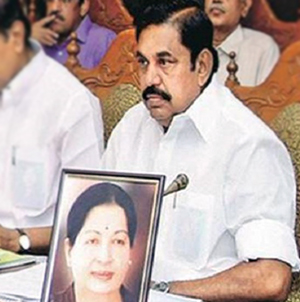Chennai, Feb 16: After a long period of political uncertainty in Tamil Nadu, it now seems that Governor Vidyasagar Rao may swear in the new Chief Minister of the state on Thursday. Reports say that E Palanisamy, who was nominated by disproportionate assets-convict AIADMK General Secretary Sasikala Natarajan, will take oath as the Tamil Nadu Chief Minister on Thursday.

Palanisamy met Governor Rao late on Wednesday evening and claimed the support of 124 AIADMK MLAs. This came after the Governor asked him to get the signatures of more than 118 MLAs from the AIADMK to form the government in the state. He has now been asked to verify the signatures.
Soon after Palanisamy, members from the O Panneerselvam camp also arrived to meet the Governor. Panneerselvam has been claiming that he has very little support right now as many of his supporters had been kept captive in the Golden Bay Resort by Sasikala.
Meanwhile, Sasikala Natarajan spent her first night in the Parappana Agrahara jail on Wednesday. Report say she slept on the floor in a cell with two other inmates. Sasikala has been given a normal cell and is getting no VIP treatment in the jail.
Sasikala surrendered before the Bengaluru court on Wednesday after the Supreme Court refused to give her any relief. The court ordered her to surrender and go to Bengaluru jail immediately.
“You know the meaning of the word immediately,” Supreme Court judge asked Sasikala’s team. “We do not intend to pass any order on this. We are not going to change anything in the judgement,” the Supreme Court said.
This came after Sasikala sought more time to surrender citing health reasons. Reports say that Sasikala’s lawyer had requested the Bengaluru court not to issue an arrest warrant against the leader while confirming that the AIADMK General Secretary will surrender by Wednesday evening.
Sasikala was convicted on Tuesday by the Supreme Court in the disproportionate assets case and was ordered to surrender immediately to serve a four year jail term. The order, however, resulted in the cancellation of her bid to be the next Chief Minister of Tamil Nadu.
Before leaving for Bengaluru on Wednesday morning, Sasikala visited the memorials of late J Jayalalithaa and MGR. On Tuesday, Sasikala had expelled acting Tamil Nadu Chief Minister O Panneerselvam and four other ‘rebel’ MLAs from the AIADMK after appointing loyalist Edappadi Palanisamy as the new Legislature Party Leader of AIADMK.







Comments
Add new comment